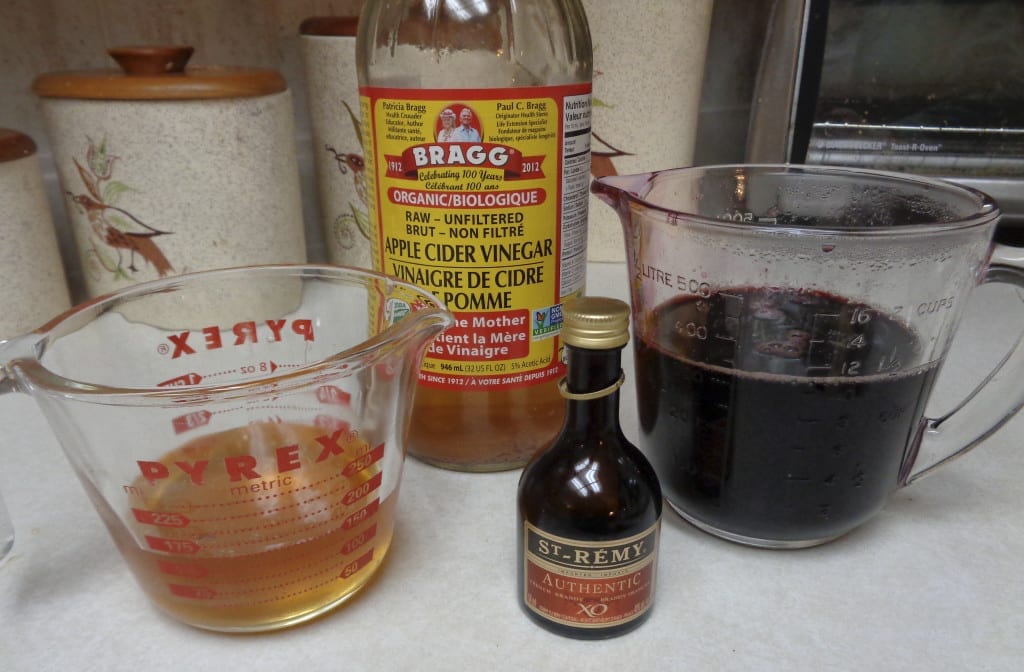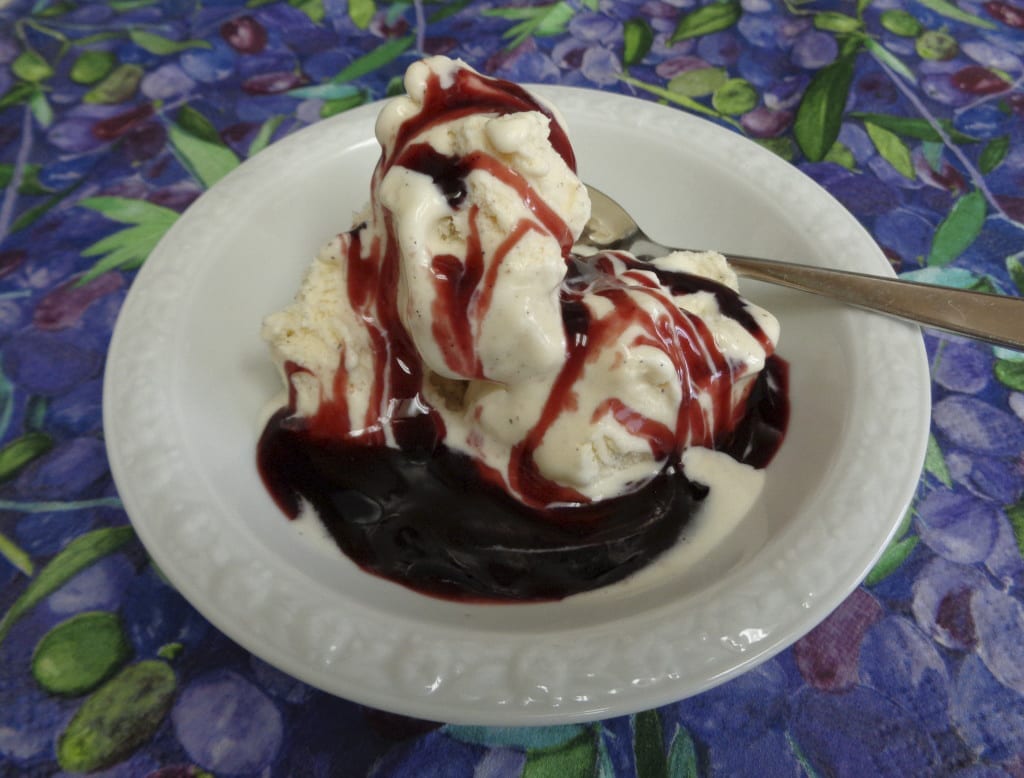Years ago my grandfather and I had returned from a trip to gather fresh fall elderberries in the Keremeos area. That evening a stroke that ultimately took him home changed those plans. Going on the trip was the last thing on his bucket list and it brought home the idea that a bucket list is not something you want to complete, rather something that gives you inspiration for living each day. It needs continual updating.
So last fall, when I did a series of posts on fall flavoured ice creams and Marti Rasmussen suggested elderberry, I was more than game to give it a go for a number of reasons. The weather pattern last year ripened everything in this area at least a month early, so the elderberry orchard just laughed when I called to see if there were any available ( the owner not the orchard ). Marti came to my rescue and sent a bottle of elderberry juice from her garden. This week, with Yule put to bed, I have finally been able to get to it.
If you don’t happen to access to an elderberry angel, it is possible to used dried berries that should be relatively easy to locate at a local health food store. Follow the directions on the package for soaking and simmering.
You will need:
1 1/2 cups elderberry juice reduction
1/2 cup honey
3 Tbsp. apple cider vinegar (optional)
1 1/2 Tbsp. brandy, vodka or something similar (optional)
1 1/2 tsp. cornstarch ( if making the ice cream sauce )
The “elder” in elderberries comes from the Anglo-Saxon “aeld,” which means fire and comes from the practice of gently blowing on flames through the hollow stems, thereby intensifying a fire. “Sambucus”, another name for elderberry comes through the Greek and means “wind instrument.” Native Americans once used elderberry branches to make flutes, so “the tree of music” is another name for elderberry that connects its usage from one side of the world to another.
There is a black and a red variety of elderberry and considerable discussion about whether red elderberries are safe to eat. For this post, we are sticking to the black/blue European variety which some doctors suggest are not advisable for pregnant or breastfeeding women. Elderberries are best cooked before consuming. Uncooked there is an cyanide like substance active in the berry. With all these things to consider, you would not think elderberries were so good for fighting colds and influenza with its anti-inflammatory and antiviral properties.
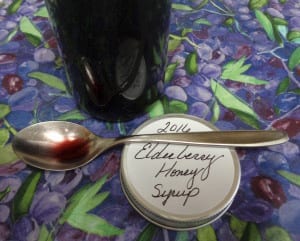 Marti sent me just over 3 cups of straight elderberry fruit juice. My first step was to put the juice on the stove, in a pot, over a gentle heat and reduce it to half the volume.
Marti sent me just over 3 cups of straight elderberry fruit juice. My first step was to put the juice on the stove, in a pot, over a gentle heat and reduce it to half the volume.
I also had a bottle of elderberry cough syrup in the cupboard that listed the additional non medicinal ingredients of honey, apple cider vinegar and alcohol. It took a little mixing and tasting but ultimately. I reached the additions listed above to the cooling elderberry juice.
Change any of the amounts to get a flavour that works for your family. More sweetness may help the medicine go down for kids as the flavour will intensify with the reduction of the juice. The alcohol is intended as a preservative and can be left out if stored in the fridge and consumed within a few weeks.
Use 1 tsp. syrup several times as day as needed for children and 1 – 2 Tbsp. for adults. It can also be diluted in hot water and enjoyed as a beverage or…. check out option two below for something cooler.
This excerpt is from Mercola.com “Antiviral components of elderberry fruit extract were tested and found to effectively inhibit Human Influenza A (H1N1 virus) in vitro, possibly by blocking the ability of the virus to infect host cells. The extract was so effective, that researchers compared it with the prescription medications Amantadine and Oseltamivir (Tamiflu).2” Elderberries were also used to combat the influenza epidemic in Panama in 1995.
Once the ingredients of the syrup are mixed, bottle and store in a dark cold location to have on hand for cold season. This really a first step, easy syrup. There are many other things that you can add for a variety of reasons. Ginger, thyme, bee balm, marshmallow root are just a few examples of other ingredients to consider if you have easy access to them.
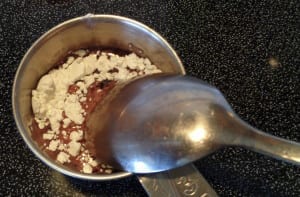 I saved 1/2 cup of the syrup to back to the original purpose of the elderberry juice, Ice Cream! Pour the syrup into a small pot, holding back a few tablespoons. Heat the juice.
I saved 1/2 cup of the syrup to back to the original purpose of the elderberry juice, Ice Cream! Pour the syrup into a small pot, holding back a few tablespoons. Heat the juice.
Mix the corn starch into the remaining elderberry syrup. Stir until the mixture is smooth and all lumps have dissolved.
Pour the mixture back into the small pot with the remaining half cup of liquid.
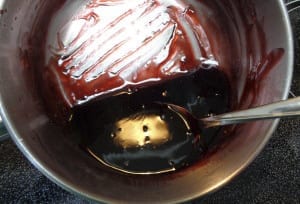 As the pot heats the liquid will begin to thicken.
As the pot heats the liquid will begin to thicken.
This is such a small amount of juice that it is important to keep watch and not allow it to burn.
Once the mixture is thick and bubbling, remove from heat and cool. If the sauce is too hot it will melt the ice cream. Not a problem if you are serving right away but not a good idea if your plan is to fully mix the sauce into softened ice cream and refreeze or to create a ripple effect by working layers of the sauce between layers of ice cream. For those ideas cooler is better.
Now doesn’t that look like a reasonable reason to have a sore throat? The medicinal properties of the elderberries and honey are intact and the ice cream will cool and sooth. Med’cin or dessert, you decide.
Elderberries – Syrup & Sauce from My Kitchen Wand


